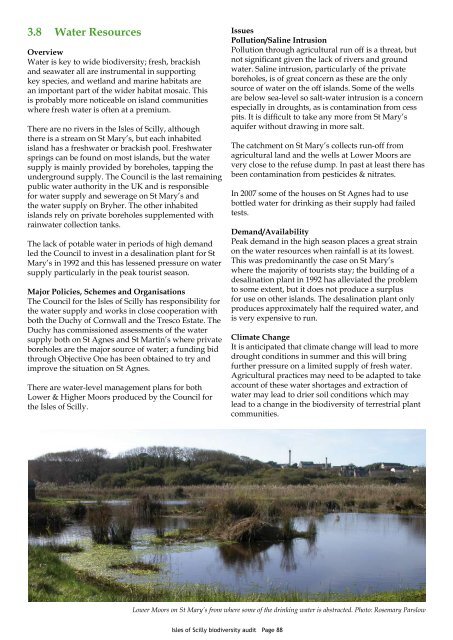The Isles of Scilly Biodiversity Audit 2008 - Cornwall Wildlife Trust
The Isles of Scilly Biodiversity Audit 2008 - Cornwall Wildlife Trust
The Isles of Scilly Biodiversity Audit 2008 - Cornwall Wildlife Trust
Create successful ePaper yourself
Turn your PDF publications into a flip-book with our unique Google optimized e-Paper software.
3.8 Water ResourcesOverviewWater is key to wide biodiversity; fresh, brackishand seawater all are instrumental in supportingkey species, and wetland and marine habitats arean important part <strong>of</strong> the wider habitat mosaic. Thisis probably more noticeable on island communitieswhere fresh water is <strong>of</strong>ten at a premium.<strong>The</strong>re are no rivers in the <strong>Isles</strong> <strong>of</strong> <strong>Scilly</strong>, althoughthere is a stream on St Mary’s, but each inhabitedisland has a freshwater or brackish pool. Freshwatersprings can be found on most islands, but the watersupply is mainly provided by boreholes, tapping theunderground supply. <strong>The</strong> Council is the last remainingpublic water authority in the UK and is responsiblefor water supply and sewerage on St Mary’s andthe water supply on Bryher. <strong>The</strong> other inhabitedislands rely on private boreholes supplemented withrainwater collection tanks.<strong>The</strong> lack <strong>of</strong> potable water in periods <strong>of</strong> high demandled the Council to invest in a desalination plant for StMary’s in 1992 and this has lessened pressure on watersupply particularly in the peak tourist season.Major Policies, Schemes and Organisations<strong>The</strong> Council for the <strong>Isles</strong> <strong>of</strong> <strong>Scilly</strong> has responsibility forthe water supply and works in close cooperation withboth the Duchy <strong>of</strong> <strong>Cornwall</strong> and the Tresco Estate. <strong>The</strong>Duchy has commissioned assessments <strong>of</strong> the watersupply both on St Agnes and St Martin’s where privateboreholes are the major source <strong>of</strong> water; a funding bidthrough Objective One has been obtained to try andimprove the situation on St Agnes.<strong>The</strong>re are water-level management plans for bothLower & Higher Moors produced by the Council forthe <strong>Isles</strong> <strong>of</strong> <strong>Scilly</strong>.IssuesPollution/Saline IntrusionPollution through agricultural run <strong>of</strong>f is a threat, butnot significant given the lack <strong>of</strong> rivers and groundwater. Saline intrusion, particularly <strong>of</strong> the privateboreholes, is <strong>of</strong> great concern as these are the onlysource <strong>of</strong> water on the <strong>of</strong>f islands. Some <strong>of</strong> the wellsare below sea-level so salt-water intrusion is a concernespecially in droughts, as is contamination from cesspits. It is difficult to take any more from St Mary’saquifer without drawing in more salt.<strong>The</strong> catchment on St Mary’s collects run-<strong>of</strong>f fromagricultural land and the wells at Lower Moors arevery close to the refuse dump. In past at least there hasbeen contamination from pesticides & nitrates.In 2007 some <strong>of</strong> the houses on St Agnes had to usebottled water for drinking as their supply had failedtests.Demand/AvailabilityPeak demand in the high season places a great strainon the water resources when rainfall is at its lowest.This was predominantly the case on St Mary’swhere the majority <strong>of</strong> tourists stay; the building <strong>of</strong> adesalination plant in 1992 has alleviated the problemto some extent, but it does not produce a surplusfor use on other islands. <strong>The</strong> desalination plant onlyproduces approximately half the required water, andis very expensive to run.Climate ChangeIt is anticipated that climate change will lead to moredrought conditions in summer and this will bringfurther pressure on a limited supply <strong>of</strong> fresh water.Agricultural practices may need to be adapted to takeaccount <strong>of</strong> these water shortages and extraction <strong>of</strong>water may lead to drier soil conditions which maylead to a change in the biodiversity <strong>of</strong> terrestrial plantcommunities.Lower Moors on St Mary’s from where some <strong>of</strong> the drinking water is abstracted. Photo: Rosemary Parslow<strong>Isles</strong> <strong>of</strong> <strong>Scilly</strong> biodiversity audit Page 88
















